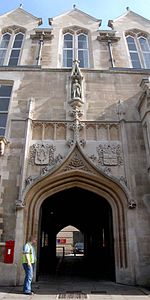Cavendishlaboratoriet



Cavendishlaboratoriet, på engelska Cavendish Laboratory, är namnet på fysikinstitutionen vid University of Cambridge. Laboratoriet stod klart 1874 och uppkallades efter den brittiske fysikern Henry Cavendish och dennes bror William (som var universitetskansler vid Cambridge och donerade de 6 300 pund som behövdes för laboratoriets byggande). 1974 flyttade laboratoriet till nya byggnader i West Cambridge och 2019 påbörjades byggandet av "Cavendish III"[1].
Till och med 2019 har Cavendishlaboratoriet producerat 30 nobelpristagare och bland upptäckter gjorda vid laboratoriet som belönats med Nobelpriset märks elektronen, neutronen och strukturen hos DNA.
Nobelpristagare från Cavendishlaboratoriet
Följande personer verksamma vid laboratoriet har fått nobelpriset:[2]
- Lord Rayleigh (Fysik, 1904)
- J.J. Thomson (Fysik, 1906)
- Ernest Rutherford (Kemi, 1908)
- William Lawrence Bragg (Fysik, 1915)
- Charles Glover Barkla (Fysik, 1917)
- Francis William Aston (Kemi, 1922)
- Charles Thomson Rees Wilson (Fysik, 1927)
- Arthur Compton (Fysik, 1927)
- Owen Willans Richardson (Fysik, 1928)
- James Chadwick (Fysik, 1935)
- George Paget Thomson (Fysik, 1937)
- Edward Victor Appleton (Fysik, 1947)
- Patrick Blackett (Fysik, 1948)
- John Cockcroft (Fysik, 1951)
- Ernest Walton (Fysik, 1951)
- Francis Crick (Fysiologi eller medicin, 1962)
- James Watson (Fysiologi eller medicin, 1962)
- Max Perutz (Kemi, 1962)
- John Kendrew (Kemi, 1962)
- Dorothy Hodgkin (Kemi, 1964)
- Brian Josephson (Fysik, 1973)
- Martin Ryle (Fysik, 1974)
- Antony Hewish (Fysik, 1974)
- Nevill Francis Mott (Fysik, 1977)
- Philip Warren Anderson (Fysik, 1977)
- Pyotr Kapitsa (Fysik, 1978)
- Allan McLeod Cormack (Fysiologi eller medicin, 1979)
- Abdus Salam (Fysik, 1979)
- Aaron Klug (Kemi, 1982)
- Didier Queloz (Fysik, 2019)
Cavendishprofessorer i fysik
Professorsstolen inrättades 1871 när laboratoriets byggande beställdes. Följande personer har varit professorer vid laboratoriet:[3]
- James Clerk Maxwell 1871–1879
- Lord Rayleigh 1879–1884
- J.J. Thomson 1884–1919
- Ernest Rutherford 1919–1937
- William Lawrence Bragg 1938–1953
- Nevill Francis Mott 1954–1971
- Brian Pippard 1971–1984
- Sam Edwards 1984–1995
- Richard Friend 1995–
Referenser
Noter
- ^ Cavendish III Arkiverad 12 juli 2019 hämtat från the Wayback Machine. på Department of Physics vid University of Cambridge.
- ^ Nobel Laureates på Department of Physics vid University of Cambridge.
- ^ Cavendish Professors på Department of Physics vid University of Cambridge.
Källor
- The History of the Cavendish på Department of Physics vid University of Cambridge.
Vidare läsning
- A history of the Cavendish laboratory 1871-1910, Longmans, Green & Co, London, 1910, 394 sidor.
Externa länkar
 Wikimedia Commons har media som rör Cavendishlaboratoriet.
Wikimedia Commons har media som rör Cavendishlaboratoriet.
Media som används på denna webbplats
Författare/Upphovsman: Pontificalibus, Licens: CC0
The third iteration of the Cavendish Laboratory under construction in 2020 on JJ Thompson Avenue in Cambridge
(c) Sebastian Ballard, CC BY-SA 2.0
Comfortable on the eye The Cavendish Laboratory, JJ Thomson Avenue.
Författare/Upphovsman: Science Museum London / Science and Society Picture Library, Licens: CC BY-SA 2.0
The apparatus used by Ernest Rutherford in his atom-splitting experiments, set up on a small table in the centre of his Cambridge University research room – Cavendish Laboratory.
Sir Ernest Rutherford (1871-1937) was born in New Zealand, coming to England to study at Cambridge in 1895, but moving to McGill University, Montreal, Canada, in 1898. There he built upon the work of H Becquerel (1852-1908) and M Curie (1867-1934) to show that radiation was made up of alpha, beta and gamma rays. In 1911, having returned to Britain, he proposed a new structure for the atom, seeing it as a miniature solar system with the nucleus at the centre and electrons orbiting it. He went on to split the atom and, in 1920, suggested that hydrogen nuclei, or protons, were the building blocks of all matter. He received the Nobel Prize for chemistry in 1908.



